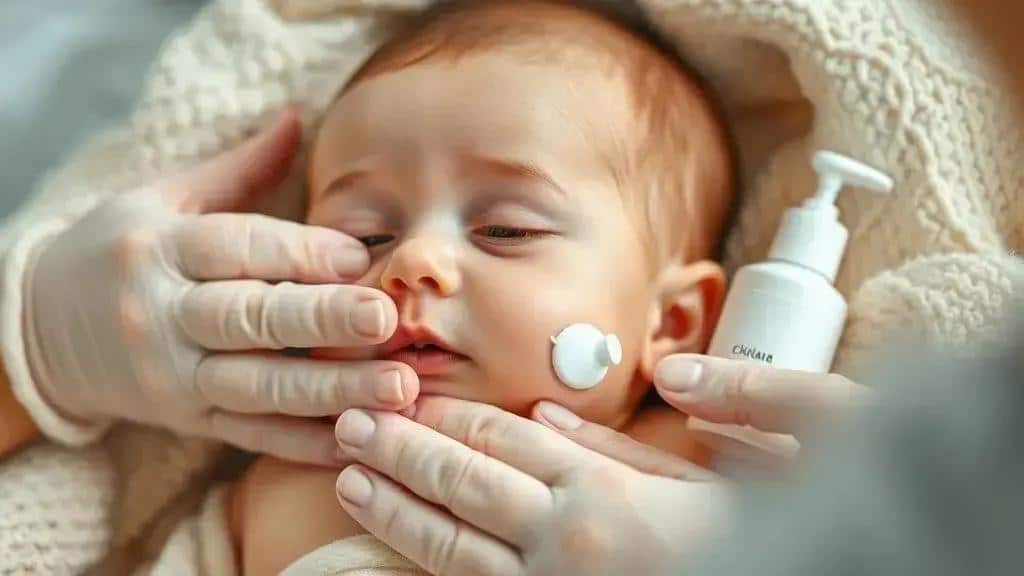Baby skincare routine for sensitive skin: what you need to know

A comprehensive baby skincare routine for sensitive skin includes gentle cleansing, daily moisturizing, frequent diaper changes, and using hypoallergenic products to prevent rashes and irritation.
A strong baby skincare routine for sensitive skin is essential for protecting your little one’s delicate skin. Have you considered what products are safest and most nourishing? Let’s dive into how to keep your baby’s skin happy and healthy.
Understanding sensitive skin in babies
Understanding sensitive skin in babies is essential for ensuring your little one is comfortable and healthy. Babies’ skin is thinner and more delicate than adult skin, making it prone to irritation and allergic reactions. Awareness of these unique characteristics helps parents choose appropriate products.
Characteristics of sensitive baby skin
Sensitive skin can manifest in various ways. Common characteristics include:
- Redness or rashes
- Dry patches or flakiness
- Itchiness or discomfort
- Increased reactions to products
Recognizing these signs is the first step in managing sensitive skin. A gentle touch goes a long way. When applying any product, always test it on a small area first. This approach helps avoid widespread irritation.
Common Causes of Sensitivity
Several factors contribute to the sensitivity of baby skin. Environmental irritants such as diaper rash, soaps, and detergents can lead to reactions. Additionally, certain fabrics may cause friction and irritation. Parents should pay close attention to these elements.
- External allergens like pollen or pet dander
- Harsh soaps and fragrances
- Overheating from heavy blankets or clothing
To protect your baby’s sensitive skin, choose hypoallergenic and fragrance-free products. Regularly monitor your baby’s skin and adjust items accordingly. Keeping an eye on changing trends can also reveal new insights.
Essential products for baby skincare
Choosing the right products is crucial for a successful baby skincare routine. With so many options available, knowing what to look for can be overwhelming. Selecting products designed for sensitive skin helps in minimizing potential irritations.
Key Ingredients to Look For
When it comes to baby skincare, certain ingredients stand out. Look for products that include:
- Aloe vera for soothing irritation
- Coconut oil for deep hydration
- Shea butter to nourish and protect
- Calendula for its calming properties
These ingredients not only hydrate but also provide a protective barrier on the skin. Always check product labels to ensure these beneficial components are included.
Types of Essential Products
There are several types of products that are essential for maintaining healthy skin in babies. These include:
- Gentle cleansers: Soft, mild soaps that won’t strip natural oils.
- Moisturizers: Creams or lotions that keep the skin hydrated.
- Diaper rash creams: Protecting creams to prevent and treat rashes.
- Sunscreen: Baby-safe formulas to protect against UV rays.
Using products specifically formulated for babies is key to avoiding irritation. Parents should avoid heavily scented items and opt for those labeled as hypoallergenic.
In addition, consider the application method. Always apply products with clean hands and in a gentle manner. This attention to detail ensures that your baby’s skin is cared for in the best way possible.
Step-by-step morning skincare routine

A well-structured morning skincare routine is vital for maintaining your baby’s healthy skin. It’s all about setting a calming atmosphere and using the right products to start the day off right.
Step 1: Gentle Cleansing
Begin the day by cleansing your baby’s face and body with a gentle cleanser. Choose a soap or wash specifically designed for babies. Apply a small amount to a soft washcloth and gently wipe your baby’s skin. Ensure that the water is warm but not too hot, as hot water can dry out their skin.
Step 2: Pat Dry
After cleansing, always pat your baby dry with a soft towel. Avoid rubbing, as this can cause irritation. Focus on areas that are prone to moisture buildup, such as the folds of skin.
Step 3: Moisturizing
Applying a good moisturizer immediately after drying helps lock in moisture. Look for a lightweight lotion or cream that contains natural ingredients. A great choice can include ingredients like coconut oil or sheaf butter. Apply a small amount and gently massage it into your baby’s skin.
Step 4: Diaper Area Care
Don’t forget about the diaper area! Apply a thin layer of diaper cream to prevent rashes and irritation. This step serves as a barrier against moisture and should be done every time you change a diaper.
Step 5: Sun Protection
If your baby will be exposed to direct sunlight, apply a baby-safe sunscreen as the final step. Use a product suitable for sensitive skin, and ensure to cover all exposed areas, even on cloudy days.
Following this simple yet effective morning skincare routine can greatly benefit your baby’s skin health. Consistency is key, so try to establish this habit every morning for optimal results.
Nighttime skincare tips for babies
Establishing a relaxing nighttime skincare routine for your baby is essential for their comfort and skin health. A proper routine helps soothe your baby before bedtime, promoting better sleep.
Create a Calm Environment
Before starting the skincare routine, make sure the environment is peaceful. Dim the lights in the room and play soft music or white noise. This calming ambiance helps ease your baby into relaxation.
Bath Time
Begin with a gentle bath using a mild, hypoallergenic cleanser. Bathing your baby in the evening can be a wonderful bonding experience. Use lukewarm water and keep the bath time short to avoid drying out their skin. After the bath, gently pat them dry with a soft towel, avoiding any harsh rubbing.
Moisturizing
Next, it’s crucial to apply a rich moisturizer. A good moisturizer not only hydrates but also locks in moisture during the night. Look for products that contain natural ingredients like sheaf butter or aloe vera for added nourishment. Apply it gently all over your baby’s body, focusing on especially dry areas.
Diaper Care
During the nighttime routine, don’t forget to check the diaper area. If your baby is prone to rashes, consider applying a protective barrier cream. This step helps prevent moisture buildup, keeping your baby’s skin healthy overnight.
Read a Bedtime Story
After applying skincare products, consider reading a bedtime story. This not only helps in winding down for sleep but also strengthens the bond between you and your baby.
By following these nighttime skincare tips, you can create a cozy and nurturing routine that promotes your baby’s skin health and well-being.
Common skincare concerns and solutions
Addressing common skincare concerns for babies is important for their well-being. By understanding these issues, parents can take proactive steps to maintain healthy skin. Some common concerns include dryness, rashes, and allergic reactions.
Dry Skin
Dry skin is a frequent issue for babies, especially in colder months. It can lead to discomfort and irritation. To combat dryness, use a moisturizing lotion after bath time. Look for products that contain natural oils like almond or coconut oil. A humidifier in your baby’s room can also help maintain moisture in the air, further alleviating dryness.
Diaper Rashes
Another common concern is diaper rash. This condition can be caused by prolonged exposure to wetness or certain irritants. To prevent diaper rash, change diapers frequently and keep the area clean and dry. Applying a barrier cream can help protect against moisture. If a rash occurs, allow your baby some diaper-free time to promote healing.
Allergic Reactions
Some babies may suffer from allergic reactions to products or fabrics. Signs of an allergy can include redness, hives, or swelling. To minimize risk, choose hypoallergenic and fragrance-free products. Always introduce new products slowly and monitor your baby’s skin for any changes.
Be mindful of the fabrics against your baby’s skin. Natural fibers like cotton are usually best. If you notice any sign of an allergy, consult with a pediatrician for tailored advice and appropriate treatment options.
Summary of Solutions
Here are a few steps to tackle these common concerns:
- Use gentle, moisturizing products regularly.
- Keep the baby’s skin dry and clean.
- Keep an eye out for products that may cause irritation.
- Consult a healthcare provider if issues persist.
By being proactive and understanding these common skincare concerns, parents can help ensure their baby’s skin remains healthy and comfortable.
FAQ – Common Questions About Baby Skincare
What should I look for in baby skincare products?
Look for products that are hypoallergenic, fragrance-free, and contain natural ingredients like aloe vera and coconut oil.
How often should I moisturize my baby’s skin?
It’s best to moisturize your baby’s skin daily, especially after bath time, to maintain hydration and prevent dryness.
What can I do to prevent diaper rash?
Change diapers frequently, keep the area clean and dry, and use a barrier cream to protect against moisture.
When should I consult a pediatrician about my baby’s skin?
Consult a pediatrician if your baby develops persistent rashes, signs of irritation, or if you’re unsure about using certain products.





